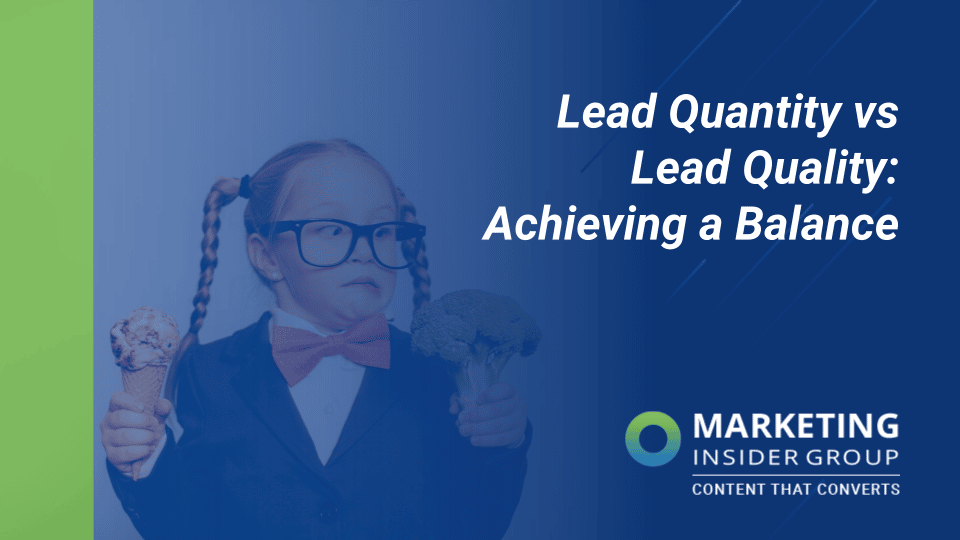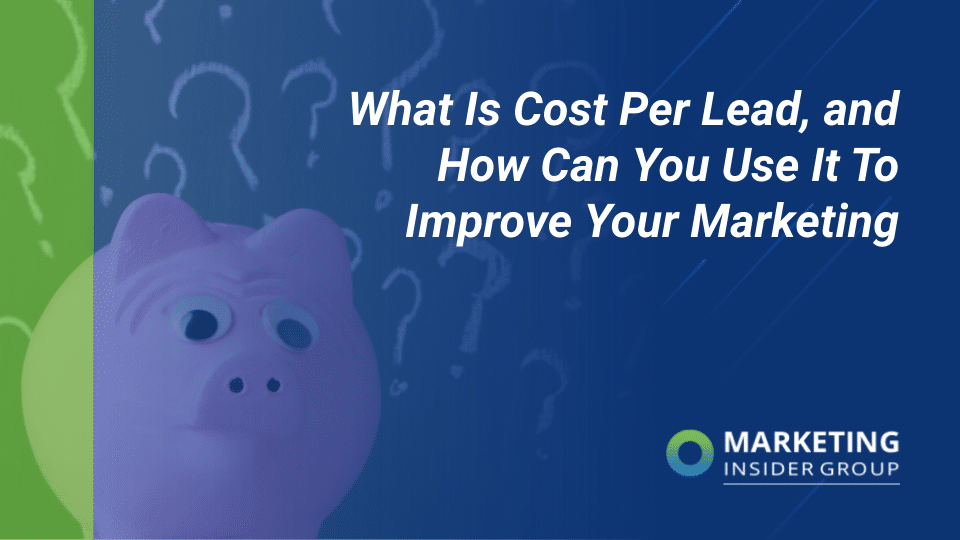
Lead Quantity vs Lead Quality: Achieving a Balance
Traditional sales and marketing strategies have long focused on lead quantity by casting a wide net to capture as many leads as possible.
The ability to attract a high volume of contacts during a lead generation campaign is usually prioritized over lead quality. The idea is that the more leads you have, the higher the chance that some of them convert into actual sales. The more the merrier, right?
Well in the case of business leads… maybe not.
This once traditional view is now changing dramatically. Business owners are getting wise, and 70% prefer quality leads over high numbers in generation alone.
Marketers are starting to appreciate the importance of targeting qualified leads, mainly due to their higher likelihood to buy. More often than not, quality leads go further along the sales funnel compared to most top of the funnel leads. This can save your sales team valuable time and effort.
The challenge lies in successfully finding these types of leads with the right marketing mix.
Key Takeaways:
- Lead quality is becoming increasingly relevant but it’s important to remember there’s no finding quality without quantity.
- You can improve your ROI overtime by focusing on quality leads.
- The key is to find a balance between the two through testing and continuous optimization.
What Does Lead Quality Mean?
Lead quality refers to the type of prospective buyers you attract based on specific parameters you’ve set. These leads are defined as having a clear intent to buy and also have the means (finances, authority, etc.) to do so.
They are individuals or organizations who are in the market to buy based on their activities, behaviors, and interactions with your brand.
Lead quality can be measured using a method called lead scoring. This method is used to rank prospects on a scale that represents each lead’s perceived value to your organization. The score determines which ones will be prioritized and what type of engagement is appropriate for each lead.
User data is an important aspect of finding quality leads. One method of collecting data is by analyzing a visitor’s behavior on your online platforms or website. Some of the activities to pay attention to include:
- The types of pages they visit (how many product/services page views vs. blog views)
- Time spent on each page
- How they found the page (was it via search engines, LinkedIn, Facebook, other social media platforms?)
- Whether or not you got their buy-in with a sign-up form on your landing page
The more B2B data you have, the clearer your unique customer profile becomes. The more you understand your prospective customer’s profile, the more you can optimize and personalize your sales/marketing approach to target them in the most effective way possible. It makes sense that focusing on lead quality is becoming a priority in many marketer’s strategies.

Image Source: Top Dog Social Media
Lead Quality and ROI
We’ve looked at content quality vs quantity but what about lead quality vs quantity? Return On Investment (ROI) is an important gauge for measuring the success of any lead generation effort. For obvious reasons, the higher the ROI, the better that particular investment is.
Businesses can look at optimizing processes to improve the ROI of a specific activity like blogging, for example.
When you focus on lead quality the chances of converting a lead into an actual sale significantly increase, and the resources spent on acquiring that lead actually pay off when they become customers.
Focusing on lead quality also improves each customer’s lifetime value by nurturing relationships and enhancing loyalty with current clients. This, in turn, improves ROI over an extended period.
Concentrating on lead quality implies shifting resource expenditure to target selected leads only. The volume of leads is likely to be affected, but while lead pools might be smaller, it also means that leads are much more targeted and highly defined.
Even though you may not be getting as many leads in general, but you’ll be spending your resources more efficiently and getting more bang for your buck.
Lead Quantity and ROI
Here’s the thing: capturing quality leads begins with attracting enough leads to sift through in the first place. This is where focusing on lead quantity comes in.
Just like playing any numbers game, more opportunities to play means more opportunities to win. That’s the basis of most sales and marketing efforts that focus on the volume of leads, and it’s a hard point to argue with.
Some circumstances may require companies to prioritize lead quantity over lead quality, especially in the initial stages when businesses have less brand awareness and find it difficult to gather enough target audience data. The need for this strategy becomes even more evident when it comes to less expensive products and companies with insubstantial marketing and sales budgets.
For companies that implement low-cost selling methods that scale well, focusing on quantity is simply a more viable option.
Bottom line, if you’re not getting enough quantity, there’s no point worrying about quality.
How Quality and Quantity Go Hand-in-Hand
Sales teams typically care about lead quality while marketing departments look at lead quantity as a measure of a successful lead generation campaign. In most cases, these two teams don’t see eye to eye because sales tends to care about conversion rates while marketing teams are looking to generate more leads in the first place.
It’s time to shift this mindset and look at both metrics as critical to success.

Image Source: AdStafe.io
While there will always be a trade-off when deciding which metrics to focus on, it’s important to remember that one cannot function without the other.
Attracting more leads will always be a prerequisite to increasing the number of sales conversions. Prioritizing lead quality becomes a necessity once business operations achieve a certain level of maturity. Doing so becomes an effective tactic to reduce overhead costs and improve ROI in the long term.
The Role of Data
Marketers have traditionally used targeted content that’s aligned with the sales pipeline. This is where the customer journey and buyer personas are put into play.
Content is typically produced based on theoretical constructs that closely resemble a buyer’s day to day interests but lacks hard data to back it up. At this point, further data is essential to direct your lead generation campaign.
The activities and behavior observed from online visitors can be used to help decide what the next steps are regarding campaign strategy and overall business objectives. Fortunately, technology has facilitated the production of CRM tools that can help gather customer data at almost every point in the buyer’s journey.
Marketers can now use the insights they gather from acquired leads to help them come up with content that will resonate with readers and get the best response from their target audience. This type of insight can only be achieved once enough leads have been gathered to paint a clearer picture of what types of prospective clients actually visit your website.
Optimize conversion rates and personalize your approach based on the results of your data gathering efforts. High-quality data collection and analysis makes it easier to take advantage of tools like targeted content that help influence the buyer’s journey to improve the likelihood of conversion.
Use features like discount offerings, chat boxes, online prompts, or exit-intent popups to provide visitors what they need to make a purchase as easily as possible.
What do your prospective customers value most? This is a question that can only be answered by research.
Achieving a Healthy Balance
There is no one-size-fits-all method for achieving the best balance when it comes to prioritizing lead quality vs. lead quantity. The best strategy involves testing, implementing, monitoring, and analyzing on a consistent basis. Building upon what works best is the only way to truly develop the perfect formula that drives the best results for your company.
So should you focus on lead quality or lead quantity?
By now, you should know that the right answer is to prioritize both. In fact, the question is no longer about whether you should pay attention to one metric at the expense of the other, but to revise the question and focus on the bottom line: Attracting and acquiring the right kind of leads specifically for your company.
Both quality and quantity drive overall success when it comes to lead generation. Marketing and sales must work hand in hand to find the right criteria for quality assessment that are based specifically on your business requirements. The ability of each department to work well together will help propel the business forward.
Sales and marketing teams must form a unified front to achieve the right balance between lead quantity and quality. We’ve already established that high lead quantity provides the best opportunity for collecting customer data, which can be used to gain insight into customer behavior and provide a clearer picture of who your target audience should be. It also lets you know their pain points, needs, and motivations as well as how you can best address them.
Finding, acquiring, attracting, and nurturing high quality leads result in better chances of conversion. Focusing on quality also improves a customer’s lifetime value and turns loyal customers into brand ambassadors.
These accounts not only provide a steady revenue stream for an extended period but also help spread the good word about your brand and help improve your company reputation once they become brand advocates. Who doesn’t love a bit of free PR?
Useful Tips to Help Find a Balance
Assign a point person
Having a unification between the sales and marketing sides of things can make or break your strategy. Having a person who bears the responsibility of managing the two is crucial.
This management role requires someone who has a broad understanding of what it takes to balance the needs of both teams. He or she should be able to develop resolutions and form a consensus between two both teams. This will help ground any lead generation decisions in data and the best interests of the business as a whole.
Set expectations
Goals and objectives must be clearly stated and understood by both parties. It is necessary to come up with realistic expectations that are fact-based, not just theoretical constructs.
A great way to do this is to implement a Service Level Agreement (SLA) between both teams whereby marketing teams are responsible for delivering a certain amount of “qualified” leads and sales teams are responsible for contacting these leads within a certain timeframe.
Define your target audience and lead generation efforts
Make sure that you’ve come up with lead definitions that everyone agrees on.
This might take some time to achieve since it can be a challenge to develop a universal definition of what your target audience should be, what their buyer’s journey looks like, or what the process entails. Don’t miss this step since effective lead scoring is critical to unifying the sales and marketing teams.
Follow a clear reporting framework
The reporting structure must be straightforward and clear to both teams. Depending on the type of industry your organization belongs to, reporting frameworks could be vastly different.
Decide on what kind of reporting structure works for you, but keep in mind that transparency and the sharing of information facilitates better alignment within the company.
Come up with a concrete plan
Needless to say, you need to have a plan in place that your team can follow.
This ensures that everyone is on the same page when it comes to executing your next steps, both literally and figuratively. It also removes any lingering doubts or second guessing what your plan of action will be when it comes to your lead generation strategy.
Provide a rewards system for high achievers
Come up with a clear set of incentives that the best performers can work towards. This will motivate even the not-so-high performers to put in their best effort to achieve their set goals.
Create a system whereby those that succeed in reaching their goals are recognized and rewarded for their efforts. Employees crave recognition for their work, so it’s a good idea to incentivize the lead generation/closing process.
Be proactive in improving your current processes
Take a closer look at your current reporting process and operations procedures.
Don’t hesitate to raise questions about those that don’t contribute positively, and introduce process improvements as often as possible. Don’t wait for mistakes to happen before addressing any processes that do not help in the long run.
Finding Your Balance is Key
Unfortunately, there will always be a trade-off between focusing on quality or quantity. We can’t have the cake and eat it too.
On the bright side however, every single business has an optimal point where both metrics are balanced. It’s up to analytics to help us find that point.
At the end of the day, you need to find a balance that works specifically within your own operations. There is always room for improvement so remember to keep testing, implementing, evaluating, and evolving your tactics to maximize the efficiency and ROI from your lead generation efforts.
If your company needs help boosting organic traffic as part of your lead generation efforts, check out our SEO Blog Writing Services or schedule a free consultation!






